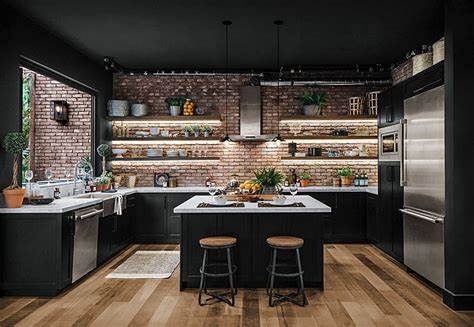The industrial design kitchen, also known as an industrial-style kitchen, is a popular and innovative interior design concept that has gained immense popularity in recent years. Inspired by the utilitarian look of industrial spaces, this style infuses a raw, rugged, and functional vibe into kitchen spaces. In this article, we will explore the essence of an it, its key features, and how it strikes a perfect balance between functionality and aesthetics, creating a unique and captivating culinary environment.
Contents
Defining the Industrial Design Kitchen
The industrial design kitchen draws its inspiration from old factories, warehouses, and industrial spaces, where raw materials and exposed structural elements coexist in harmony. This style embraces an unfinished and minimalistic approach, highlighting the beauty of the raw and the functional. It is characterized by a mix of sturdy materials, earthy tones, and utilitarian objects that seamlessly blend into the overall design.
Key Features of an Industrial Design Kitchen
Exposed Structural Elements
One of the defining features of an industrial design kitchen is the exposure of structural elements such as brick walls, concrete floors, and ceiling beams. These elements add a touch of authenticity and ruggedness to the space.
Industrial Materials
The use of industrial materials is a fundamental aspect of this style. Stainless steel, concrete, reclaimed wood, and metal surfaces are common materials employed in an it. These materials are not only durable and functional but also contribute to the industrial aesthetic.
Open Shelves and Storage
In an industrial design kitchen, open shelves and storage solutions take precedence over closed cabinets. This not only showcases kitchenware and utensils but also adds to the uncluttered and utilitarian look.
Minimalistic Color Palette
The color palette typically revolves around neutral and earthy tones, such as grays, blacks, browns, and whites. These colors create a calm and soothing ambiance while accentuating the raw industrial appeal.
Statement Lighting
Industrial-style lighting fixtures, such as pendant lights with exposed bulbs or metal shades, are often used to add a focal point and enhance the overall industrial charm.
Unfinished Surfaces
The charm of an industrial design kitchen lies in embracing the beauty of unfinished surfaces. Distressed finishes and imperfections are celebrated, creating a unique and inviting atmosphere.
Balancing Functionality and Aesthetics
While industrial design kitchens exude a rugged and utilitarian vibe, they do not compromise on functionality and practicality. The design elements are carefully curated to ensure that the kitchen remains efficient and user-friendly. The open shelving and storage solutions, for instance, allow easy access to kitchen essentials, making the cooking process seamless. The use of stainless steel and other durable materials ensures that the kitchen is not only visually appealing but also capable of withstanding heavy-duty use.
Moreover, the spacious layout and minimalistic design contribute to a clutter-free and organized environment, where every element serves a purpose. The combination of functionality and aesthetics in an makes it a preferred choice for both professional chefs and home cooks who value practicality and style.
The industrial design kitchen is a captivating fusion of raw aesthetics and practical functionality, inspired by the rugged appeal of industrial spaces. With exposed structural elements, industrial materials, and a minimalistic color palette, this style creates an inviting culinary environment that celebrates the beauty of the utilitarian. Balancing both form and function, an industrial design kitchen is a testament to the timeless charm of industrial-inspired interior design, making it a popular choice for those seeking a distinctive and functional culinary space.

